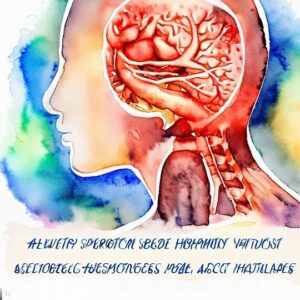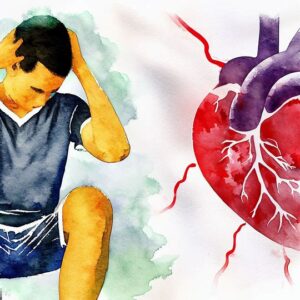Chronic Stress and Hemorrhagic Stroke in Teenagers? – Chronic stress may increase the risk of hemorrhagic stroke in teenagers. Learn about the research on this link and how to reduce your risk.
Chronic stress can profoundly impact a person’s health, and teenagers are not immune to its effects. One of the most concerning risks associated with chronic stress is the increased likelihood of hemorrhagic stroke. Hemorrhagic stroke is a type of stroke that occurs when a blood vessel in the brain ruptures and bleeds into the surrounding tissue. This can cause significant damage to the brain and can even be fatal.
Understanding the causes of hemorrhagic stroke is an important step in preventing it. While several risk factors are associated with this type of stroke, including high blood pressure and smoking, chronic stress is emerging as a significant contributor. Chronic stress can cause the blood vessels in the brain to weaken and become more susceptible to rupture. This risk is particularly high in teenagers, who are already undergoing significant changes in their bodies and minds.
Table of Contents
Key Takeaways
- Chronic stress can increase the risk of hemorrhagic stroke in teenagers.
- Hemorrhagic stroke occurs when a blood vessel in the brain ruptures and bleeds into the surrounding tissue.
- Preventive measures, such as stress management techniques, can help reduce teenagers’ risk of hemorrhagic stroke.
Understanding Hemorrhagic Stroke and its Causes
Definition of Hemorrhagic Stroke
A hemorrhagic stroke occurs when bleeding inside the brain or in the space between the brain and its outer covering layer. This type of stroke is less common than an ischemic stroke, when a blood clot blocks a blood vessel in the brain. However, hemorrhagic strokes are often more severe and can lead to death or permanent brain damage if not treated immediately.
There are two main types of hemorrhagic stroke: intracerebral hemorrhage and subarachnoid hemorrhage. Intracerebral hemorrhage occurs when there is bleeding within the brain tissue, while subarachnoid hemorrhage occurs when there is bleeding in the area between the brain and the membrane that covers it.
Common Causes of Hemorrhagic Stroke
Several risk factors can increase the likelihood of experiencing a hemorrhagic stroke. High blood pressure, or hypertension, is the most common cause of hemorrhagic stroke. When blood pressure is too high, it can weaken blood vessels in the brain and make them more likely to rupture and bleed.
Other risk factors for hemorrhagic stroke include:
- Cerebral amyloid angiopathy: a condition in which protein deposits build up in the walls of blood vessels in the brain, making them more likely to rupture.
- Arteriovenous malformations: abnormal connections between arteries and veins in the brain that can lead to bleeding.
- Blood clotting disorders: conditions that affect the body’s ability to form blood clots, which can increase the risk of bleeding.
- Head injuries: trauma to the head can cause bleeding in the brain.
- Use of blood-thinning medications: medications that prevent blood clots can increase the brain’s bleeding risk.
In young adults, intracranial hemorrhage is a rare but serious incident stroke. It can be caused by high blood pressure, aneurysms, arteriovenous malformations, and bleeding disorders.
It is important to seek immediate medical attention if you experience any warning signs of hemorrhagic stroke, such as sudden severe headache, dizziness, confusion, numbness or weakness on one side of the body, and difficulty speaking or understanding speech. Treatment for hemorrhagic stroke may include medication to control blood pressure, surgery to repair blood vessels or remove blood clots, and rehabilitation to help regain lost functions.
Chronic Stress and Hemorrhagic Stroke in Teenagers – Sources
The Impact of Chronic Stress on Teenagers
Definition of Chronic Stress
Chronic stress is a type of stress that occurs when an individual experiences prolonged and ongoing stressors that exceed their ability to cope. This type of stress can lead to physical and emotional exhaustion and negatively affect an individual’s mental and physical health. Chronic stress can be caused by various factors, including work-related stress, financial stress, relationship problems, and chronic illness.
Factors Contributing to Chronic Stress in Teenagers
Teenagers are particularly susceptible to chronic stress due to the many changes and pressures they face during this time of their lives. Some of the factors that can contribute to chronic stress in teenagers include academic pressure, social pressure, family conflict, and hormonal changes. Additionally, lifestyle factors such as lack of sleep, poor diet, and lack of exercise can also contribute to chronic stress.
Research has shown that chronic stress can significantly impact teenagers’ mental and physical health. Chronic stress has been linked to depression, anxiety, smoking, inflammation, high blood pressure (hypertension), emotional stress, muscle weakness, confusion, disability, occupation, infections, migraines with aura, cancer, and glucose problems.
To combat chronic stress, teenagers can try various stress-reducing techniques, such as meditation, yoga, and calming apps. Teenagers need to prioritize their mental and physical health by practicing self-care and seeking support when needed.
Exploring the Link Between Chronic Stress and Hemorrhagic Stroke in Teenagers

Chronic stress can significantly impact an individual’s physical and mental health. Recent studies have shown that chronic stress can also increase teenagers’ risk of hemorrhagic stroke.
Research Evidence Linking Chronic Stress and Hemorrhagic Stroke
A study published in the American Heart Association’s Stroke Journal found that young adults with post-traumatic stress disorder (PTSD) were at an increased risk of hemorrhagic stroke. The study examined the independent effects of PTSD, selective serotonin, and norepinephrine reuptake inhibitors (SSRI and SNRI) on the risk of incident hemorrhagic stroke in a nationwide sample of 1.1 million young and middle-aged veterans. The results showed that PTSD was associated with an increased risk of hemorrhagic stroke, and antidepressants did not significantly alter this risk.
Another study published in the National Library of Medicine found that hemorrhagic stroke is more common earlier in adulthood, representing up to 50% of incident stroke cases in adults under 45. As the economic burden and physical ramifications of hemorrhagic stroke may exceed that of ischemic stroke, it is important to identify the risk factors associated with this type of stroke.
Possible Mechanisms Through Which Chronic Stress May Contribute to Hemorrhagic Stroke
Chronic stress can lead to high blood pressure, a significant risk factor for hemorrhagic stroke. When blood pressure is too high, the brain’s blood vessels can weaken, leading to bleeding. Chronic stress can also lead to inflammation, further damaging blood vessels and increasing the risk of bleeding.
Studies have also suggested that chronic stress can activate the coagulation system, increasing the risk of blood clots and bleeding. Thrombin, a protein involved in the coagulation system, is elevated in individuals experiencing chronic stress. Elevated levels of thrombin can increase the risk of bleeding and blood clots.
Occupation and lifestyle factors can also contribute to chronic stress and increase the risk of hemorrhagic stroke. Individuals with high-stress jobs or who experience chronic stress due to lifestyle factors such as financial difficulties or relationship problems may be at an increased risk of hemorrhagic stroke.
Conclusion
Chronic stress can significantly impact an individual’s physical and mental health, and recent studies have shown that it can also increase the risk of hemorrhagic stroke in teenagers. The mechanisms through which chronic stress contributes to hemorrhagic stroke are complex and involve factors such as high blood pressure, inflammation, and coagulation.
It is important for individuals to manage their stress levels through meditation, yoga, or calming apps, and to seek medical attention if they experience warning signs of stroke, such as dizziness or coma. A neurologist can diagnose hemorrhagic stroke through blood tests and magnetic resonance imaging (MRI) and may prescribe anticoagulants or other treatments to manage the condition. Overall, it is essential to manage chronic stress to reduce the risk of hemorrhagic stroke and other related health conditions.
Preventive Measures and Management

Identifying and Managing Chronic Stress in Teenagers
Chronic stress is a significant risk factor for hemorrhagic stroke in teenagers. Identifying and managing stress in teenagers is essential to reduce the risk of stroke. Parents, teachers, and healthcare providers should know the warning signs of chronic stress, such as anxiety, depression, and muscle weakness. If a teenager shows signs of chronic stress, they should be evaluated by a doctor to determine the best course of action.
Stress management techniques can help reduce the risk of stroke in teenagers. Techniques like meditation, yoga, and calming apps can help reduce stress levels. Exercise is also an effective stress management technique, as it can improve blood flow and reduce inflammation.
Strategies for Preventing Hemorrhagic Stroke in Teenagers
Preventing hemorrhagic stroke in teenagers involves managing risk factors such as high blood pressure, smoking, and diabetes. Lifestyle factors, such as healthy eating and regular exercise, can also help reduce the risk of stroke.
Parents and healthcare providers should encourage teenagers to adopt healthy habits, such as eating a balanced diet and exercising regularly. They should also be aware of the warning signs of stroke, such as sudden muscle weakness, confusion, and dizziness. If a teenager experiences any of these symptoms, they should seek medical attention immediately.
Importance of Mental Health Support and Stress Reduction Techniques
Mental health support and stress reduction techniques are essential in preventing hemorrhagic stroke in teenagers. Chronic stress can lead to high blood pressure, a significant stroke risk factor. Mental health support, such as counseling and therapy, can help teenagers manage stress and reduce the risk of stroke.
Stress reduction techniques like meditation and yoga can also help reduce stress levels. These techniques can improve blood flow and reduce inflammation, which can help prevent stroke. Parents and healthcare providers should encourage teenagers to adopt stress reduction techniques to reduce the risk of stroke.
In conclusion, preventing hemorrhagic stroke in teenagers involves managing risk factors such as high blood pressure and diabetes, adopting healthy habits, and managing chronic stress. Parents, teachers, and healthcare providers should be aware of the warning signs of stroke and encourage teenagers to seek medical attention if they experience any symptoms. Mental health support and stress reduction techniques can also help reduce the risk of stroke. By adopting these strategies, teenagers can reduce their risk of stroke and improve their overall health and well-being.
Chronic Stress and Hemorrhagic Stroke in Teenagers – Sources
- Hemorrhagic Stroke: What It Is, Causes, Symptoms & Treatment
- 2022 Guideline for the Management of Patients With Spontaneous …
- Cerebral Hemorrhage: Pathophysiology, Treatment, and Future Directions
- Stroke – Diagnosis and treatment – Mayo Clinic
Conclusion

Chronic stress is a major risk factor for hemorrhagic stroke in teenagers. The stress response triggers the release of hormones that increase blood pressure and heart rate, leading to damage to the blood vessels in the brain. Over time, this can result in the development of small aneurysms or weakened blood vessels that are more susceptible to rupture.
Research has shown that chronic stress is associated with an increased risk of hemorrhagic stroke in teenagers. A study published in the journal Stroke found that emotional stress was a significant risk factor for primary intracerebral hemorrhage, a type of hemorrhagic stroke that occurs when blood vessels in the brain rupture and bleed into the surrounding tissue.
Another study published in the journal Chronic Stress found that chronic stress was associated with changes in brain structure and function that increased the risk of stroke. The study found that chronic stress was associated with increased activity in the amygdala, a part of the brain involved in the stress response, and decreased activity in the prefrontal cortex, a part of the brain involved in decision-making and impulse control.
It is important to identify and manage chronic stress to reduce the risk of hemorrhagic stroke in teenagers. This can be done through various strategies, including relaxation techniques such as meditation and yoga, regular exercise, and talking to a mental health professional.
It is important to note that while chronic stress is a significant risk factor for hemorrhagic stroke in teenagers, it is not the only factor. Other risk factors include high blood pressure, smoking, and drug use. By addressing these risk factors and implementing strategies to manage chronic stress, teenagers can reduce their risk of hemorrhagic stroke and improve their overall health and well-being.
Frequently Asked Questions
What are the symptoms of hemorrhagic stroke in teenagers?
The symptoms of hemorrhagic stroke in teenagers can vary depending on the severity and location of the stroke. Some common symptoms include sudden severe headache, difficulty speaking or understanding speech, weakness or numbness on one side of the body, loss of balance or coordination, and vision problems. It is important to seek medical attention immediately if any of these symptoms occur.
Can chronic stress increase the risk of hemorrhagic stroke in teenagers?
Yes, chronic stress can increase the risk of hemorrhagic stroke in teenagers. Studies have shown that stress can cause changes in blood pressure and heart rate, which can lead to damage of blood vessels in the brain. Stress can also contribute to unhealthy lifestyle habits, such as lack of exercise and poor diet, which can further increase the risk of stroke.
What are some ways to manage chronic stress in teenagers?
There are several ways to manage chronic stress in teenagers, including regular exercise, healthy eating, getting enough sleep, practicing relaxation techniques such as deep breathing or meditation, and engaging in activities they enjoy. It is also important for teenagers to have a support system, whether through friends, family, or a mental health professional.
What are the potential long-term effects of hemorrhagic stroke in teenagers?
The potential long-term effects of hemorrhagic stroke in teenagers can vary depending on the severity and location of the stroke. Some common long-term effects include paralysis, cognitive impairment, and speech and language difficulties. Rehabilitation and therapy can help manage these effects, but some may be permanent.
How can parents and caregivers help teenagers cope with stress?
Parents and caregivers can help teenagers cope with stress by encouraging healthy lifestyle habits, providing a supportive and understanding environment, and helping them find healthy ways to manage stress, such as through exercise or relaxation techniques. It is also important for parents and caregivers to recognize the signs of stress in teenagers and seek professional help if necessary.
Are there any genetic factors that contribute to hemorrhagic stroke in teenagers?
Yes, some genetic factors can contribute to hemorrhagic stroke in teenagers. These factors include genetic disorders affecting blood vessels, such as cerebral autosomal dominant arteriopathy with subcortical infarcts and leukoencephalopathy (CADASIL) and hereditary hemorrhagic telangiectasia (HHT). Teenagers with a family history of stroke need to discuss their risk with their healthcare provider.


